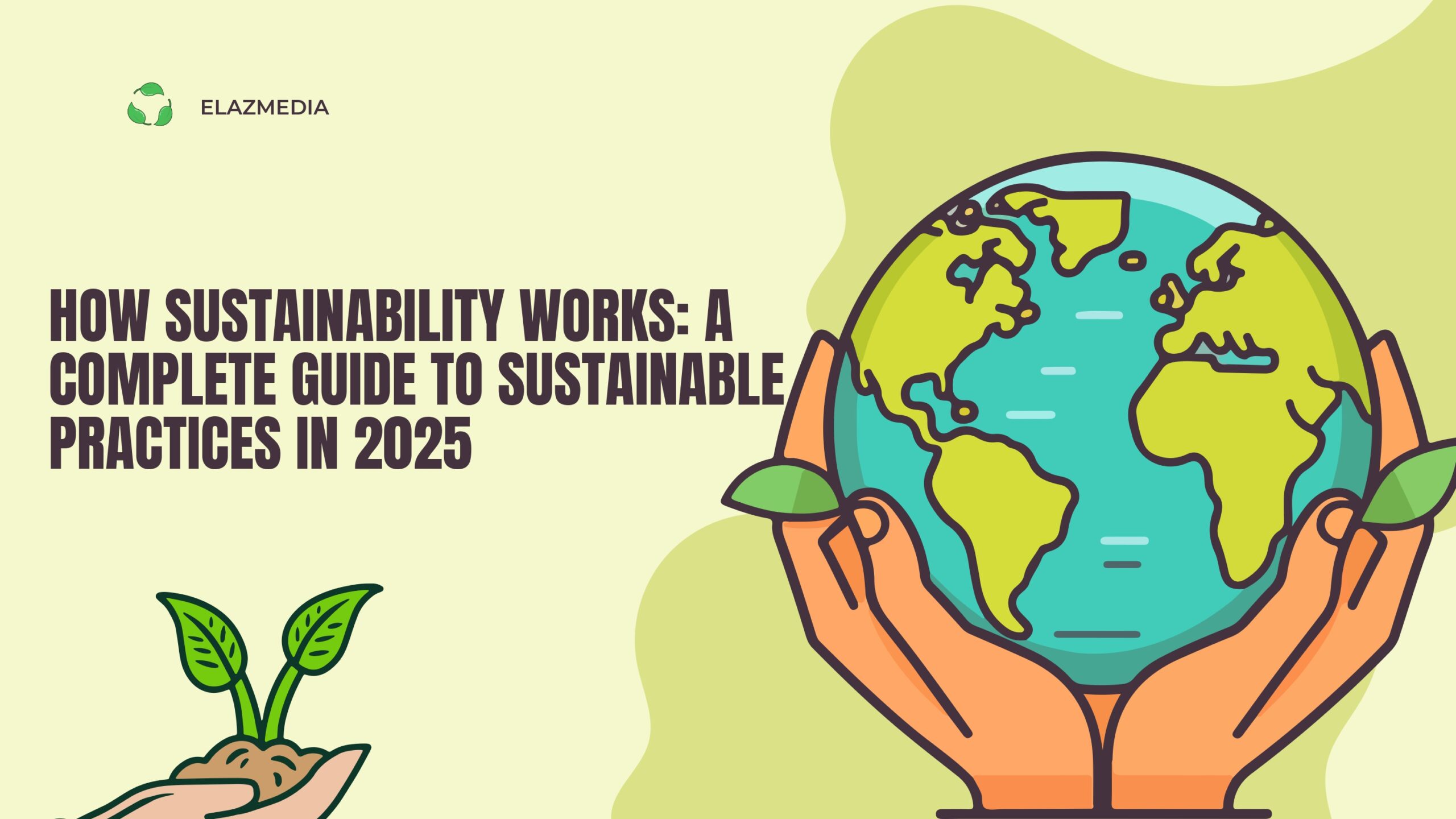Table of Contents

Introduction: What Is Sustainability and How Does It Work?
Sustainability works by balancing economic growth, environmental protection, and social equity to meet present needs without compromising future generations’ ability to meet theirs. In today’s world, understanding how sustainability works is crucial as businesses, governments, and individuals face mounting environmental challenges including climate change, resource depletion, and biodiversity loss.
United Nations Sustainable Development Goals
In today’s world, understanding how sustainability works is crucial as businesses, governments, and individuals work toward the United Nations Sustainable Development Goals while facing mounting environmental challenges..
This comprehensive guide explains how sustainability works across different sectors, its core principles, and practical implementation strategies that create lasting positive impact.
Understanding How Sustainability Works: The Fundamental Principles
Sustainability works through the integration of three interconnected systems that support long-term viability:
1. Resource Management and Conservation
At its foundation, sustainability works by ensuring resources are used efficiently and renewed naturally. This involves:
- Renewable resource optimization: Using solar, wind, and water power effectively
- Circular economy principles: Minimizing waste through recycling and reuse
- Conservation strategies: Protecting natural habitats and biodiversity
2. Systems Thinking Approach
Sustainability works when we recognize the interconnectedness of environmental, social, and economic systems. Every action in one area affects the others, creating ripple effects throughout the entire ecosystem.
The Three Pillars: How Sustainability Works in Practice
Understanding how sustainability works requires examining its three fundamental pillars, often called the “triple bottom line”:
Environmental Sustainability: Protecting Our Planet
Environmental sustainability works by following principles outlined in the EPA’s sustainability guidelines, which emphasize reducing carbon emissions through renewable energy adoption...
Environmental sustainability works by:
- Reducing carbon emissions through renewable energy adoption
- Preserving biodiversity via habitat conservation
- Managing water resources through efficient usage and protection
- Minimizing pollution across air, water, and soil
Key Metric: Companies implementing environmental sustainability report average emission reductions of 30-40% within five years.
Economic Sustainability: Ensuring Long-term Prosperity
Economic sustainability works through:
- Sustainable business models that generate profit while preserving resources
- Green investments in renewable technologies and infrastructure
- Cost efficiency through waste reduction and resource optimization
- Innovation drivers creating new markets and opportunities
Real Impact: Businesses adopting sustainable practices see 18% higher ROI on average compared to traditional models.
Social Sustainability: Building Equitable Communities
Social sustainability works by:
- Promoting fair labor practices and living wages
- Ensuring community well-being through inclusive development
- Supporting education and health initiatives
- Fostering cultural preservation and social cohesion
How Sustainability Works in Business: Practical Implementation
Corporate Sustainability Strategies That Work
Modern businesses demonstrate how sustainability works through concrete actions: as recommended by the World Business Council for Sustainable Development..
- Setting Science-Based Targets
- Align emission reduction goals with climate science
- Establish measurable milestones and tracking systems
- Supply Chain Transformation
- Partner with sustainable suppliers
- Implement transparency and traceability measures
- Circular Business Models
- Design products for longevity and recyclability
- Create take-back and refurbishment programs
- Stakeholder Engagement
- Involve employees in sustainability initiatives
- Collaborate with communities and NGOs
Measuring How Sustainability Works: Key Performance Indicators
Effective sustainability works when progress is measurable:
- Carbon footprint reduction (tons of CO2 equivalent)
- Water usage efficiency (gallons per unit produced)
- Waste diversion rates (percentage recycled/composted)
- Social impact scores (community benefit assessments)
Real-World Example: How Sustainability Works at Unilever
Unilever’s Sustainable Living Plan demonstrates how sustainability works in practice:
Implementation Strategy
- Reduced environmental footprint by 50% per consumer use
- Enhanced livelihoods for millions in the supply chain
- Improved health and well-being for billions globally
Measurable Results
- €1.2 billion cost savings from eco-efficiency programs
- 70% sustainable sourcing of agricultural raw materials
- 28% reduction in CO2 emissions from manufacturing
This example shows how sustainability works to create both environmental benefits and business value simultaneously.
How Sustainability Works: Benefits and Outcomes
Environmental Benefits
- Climate change mitigation through reduced emissions
- Ecosystem preservation protecting biodiversity
- Resource conservation ensuring future availability
Economic Advantages
- Cost reduction through efficiency improvements (average 20-30% savings)
- Market differentiation attracting conscious consumers
- Risk mitigation against resource scarcity and regulations
- Innovation opportunities in green technologies
Social Improvements
- Enhanced quality of life in communities
- Job creation in sustainable industries
- Health benefits from reduced pollution
- Educational advancement through awareness programs
The Future: How Sustainability Works in Emerging Trends
Technology Integration
- AI and IoT optimizing resource usage
- Blockchain ensuring supply chain transparency
- Clean tech innovations advancing renewable energy
Policy Evolution
- Carbon pricing mechanisms incentivizing reduction
- Circular economy legislation mandating recycling
- ESG reporting requirements standardizing disclosure
Conclusion: Making Sustainability Work for Everyone
Understanding how sustainability works empowers individuals and organizations to make informed decisions that benefit people, planet, and profit. As we’ve explored, sustainability works through integrated approaches that balance immediate needs with long-term viability.
The success stories and frameworks presented demonstrate that sustainability works best when implemented holistically, measured consistently, and adapted continuously. Whether you’re a business leader, policymaker, or concerned citizen, knowing how sustainability works enables you to contribute meaningfully to a more sustainable future.
By embracing these principles and practices, we can ensure sustainability works not just as a concept, but as a practical pathway to prosperity for current and future generations.
Take Action: Start implementing sustainable practices today. Whether reducing energy consumption, supporting sustainable businesses, or advocating for policy change, every action counts in making sustainability work for our collective future.